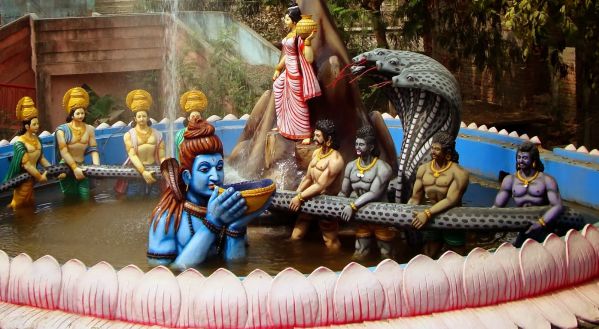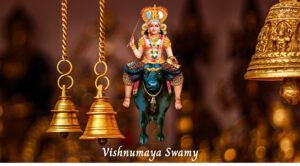Lord Shiva, one of the principal deities in Hinduism, is revered as the Supreme Being, the destroyer of evil, and the transformer within the Holy Trinity, alongside Brahma (the creator) and Vishnu (the preserver). Lord Shiva is often depicted with matted hair, a third eye on his forehead, a crescent moon adorning his locks, a serpent around his neck, and the river Ganga flowing through his hair.
The multifaceted nature of Lord Shiva is reflected in the various names and epithets by which he is known, each carrying a unique significance and story. Here are some of the significant names of Lord Shiva along with their stories:
1. Shiva:
– Significance: The name “Shiva” itself means “The Auspicious One” or “The Benevolent.” Lord Shiva is often addressed by this name to emphasize his benevolent and compassionate nature.
2. Mahadeva:
– Significance: Translating to “The Great God” or “God of All Gods,” Mahadeva underscores Shiva’s supreme status among the divine pantheon.
3. Maheshwara:
– Significance: “Maheshwara” means “The Great Lord” or “Lord of the Universe.” This name highlights Lord Shiva’s role as the cosmic ruler and supreme deity.
4. Neelakantha:
– Significance: “Neelakantha,” or “The Blue-Throated One,” refers to an incident during the churning of the ocean (Samudra Manthan) when Lord Shiva drank the poison (halahala) that emerged, turning his throat blue to save the world from destruction.

Story Behind Lord Shiva Name “Neelkantha”
The name “Neelakantha” is associated with a significant episode in Hindu mythology involving Lord Shiva. The story behind the name revolves around the churning of the ocean, a celestial event known as Samudra Manthan, in which both the Devas (celestial beings) and Asuras (demons) collaborated to obtain the nectar of immortality (amrita) from the ocean.
During the churning process, various divine and mystical beings emerged from the ocean, including the poison known as “halahala.” This poison was so potent that it had the potential to destroy all of creation. Faced with the imminent catastrophe, the Devas and Asuras sought the help of Lord Shiva to save the world.
In response to their plea, Lord Shiva agreed to take on the responsibility of consuming the lethal poison. He did so not out of a desire for self-preservation but out of compassion for all living beings. As Lord Shiva drank the poison, his consort, Goddess Parvati, anxiously watched. To prevent the poison from reaching his stomach, Lord Shiva held it in his throat.
The poison turned Lord Shiva’s throat blue, earning him the epithet “Neelakantha,” which literally translates to “The Blue-Throated One” in Sanskrit. This selfless act of consuming the poison to protect the world is a testament to Lord Shiva’s compassion and his willingness to endure personal suffering for the greater good.
The Neelakantha episode symbolizes the concept that even in the face of immense challenges and dangers, divine intervention and sacrifice can lead to the preservation of the universe. Lord Shiva’s blue throat serves as a constant reminder of his benevolence and his role as a protector who willingly takes on the burdens of the world.
Devotees often invoke the name Neelakantha in prayers and hymns as a way of expressing gratitude for Lord Shiva’s selfless act and seeking his blessings for protection, wisdom, and spiritual growth. The story of Neelakantha continues to be a cherished and significant narrative in Hindu mythology, highlighting the depth of Lord Shiva’s character and the profound symbolism associated with his various manifestations.
5. Ardhanarishvara:
– Significance: This unique form of Shiva is depicted as half male and half female, representing the union of Shiva and his consort Parvati. It signifies the inseparable nature of the male and female principles, emphasizing the concept of Ardha-Nareeshwara (half-man, half-woman).
Story Behind Lord Shiva Name “Ardhanarishvara”
The name “Ardhanarishvara” is associated with a unique and profound aspect of Lord Shiva, where he is depicted as half male and half female, symbolizing the union of masculine and feminine energies. The word “Ardhanarishvara” is a combination of three Sanskrit words: “Ardha” (half), “Nari” (woman), and “Ishvara” (Lord), collectively meaning “The Lord who is half woman.” This divine form of Lord Shiva represents the inseparable and complementary nature of the male and female principles in the universe.
The story behind Ardhanarishvara is deeply rooted in Hindu mythology and emphasizes the concept of cosmic balance and unity of opposites. There are different versions of the myth, but one of the well-known stories is associated with the celestial event known as the “Churning of the Ocean” or “Samudra Manthan.”
According to one version of the story:
During the churning of the ocean by the Devas (celestial beings) and Asuras (demons) to obtain the nectar of immortality (amrita), a divine elixir emerged. As the Devas and Asuras quarreled over the distribution of the nectar, a demon named Rahu deceitfully consumed some of it. The Sun and Moon, who had witnessed this act, reported it to Lord Vishnu.
In response, Lord Vishnu severed Rahu’s head with his Sudarshana Chakra. However, because Rahu had already consumed the nectar, he did not die. Instead, his severed head became known as Ketu. Rahu and Ketu, now immortal, sought the blessings of Lord Shiva to be restored to their original forms.
Lord Shiva, known for his compassion, granted their request but in a unique way. He merged Rahu and Ketu into his own being, creating a form that was half male (representing Rahu) and half female (representing Ketu). This extraordinary form, embodying the union of opposites, came to be known as Ardhanarishvara.
The Ardhanarishvara form symbolizes the harmonious coexistence and interdependence of the masculine and feminine energies in the universe. It underscores the idea that creation is a result of the perfect union of Shiva (the male principle) and Shakti (the female principle). Devotees worship Ardhanarishvara to seek blessings for marital harmony, balance in life, and the understanding of the complementary aspects of existence.
The story of Ardhanarishvara is a powerful metaphor for the integral relationship between the male and female energies, highlighting the concept of divine balance and the interconnectedness of all aspects of creation.
6. Rudra:
– Significance: “Rudra” means “The Roarer” or “The Howler.” In Vedic literature, Rudra is a fierce aspect of Lord Shiva associated with storms, thunder, and destruction.
7. Pashupati:
– Significance: “Pashupati” translates to “Lord of All Creatures” or “Protector of Beings.” This name signifies Shiva’s role as the divine protector of all living beings.
Story Behind Lord Shiva Name “Pashupati”
The name “Pashupati” is associated with a significant aspect of Lord Shiva and is derived from the Sanskrit words “Pashu,” meaning “beings” or “creatures,” and “Pati,” meaning “Lord” or “Master.” Therefore, “Pashupati” translates to “The Lord of All Beings” or “The Master of Animals.”
The origin of the name Pashupati is connected to an ancient legend that illustrates Lord Shiva’s compassion and his role as the divine protector of all living beings. One of the prominent stories associated with the name Pashupati is related to the city of Kashi (Varanasi) and a sage named Daksha.
According to the legend:
Sati, the daughter of the sage Daksha, married Lord Shiva against her father’s wishes. Daksha held a grand yajna (sacrificial ritual) but intentionally did not invite Sati and Shiva. Despite this, Sati attended the yajna, where she was met with disrespect and insults from Daksha. Unable to bear the humiliation, Sati immolated herself in the sacrificial fire.
Enraged by the tragic death of his wife, Lord Shiva took the form of Virabhadra, a fierce and powerful warrior, and disrupted Daksha’s yajna. In the chaos that ensued, Shiva carried the lifeless body of Sati on his shoulder and began performing the cosmic dance of destruction, known as the Tandava.
To prevent the catastrophic consequences of Shiva’s wrath, the other deities pleaded with Lord Vishnu, who intervened by using his Sudarshana Chakra to dismember Sati’s body. The body parts fell at different locations across the Indian subcontinent, and each of these places became a Shakti Peetha, a sacred site associated with the divine feminine.
In Kashi (Varanasi), where Sati’s earring (Pasha) fell, Lord Shiva manifested as Pashupati. In this form, Shiva is revered as the divine protector of all beings, symbolizing his compassion and guardianship over the animal kingdom. The name Pashupati emphasizes Shiva’s role as the Lord who cares for and protects all creatures, embodying the interconnectedness of life.
Devotees worship Pashupati for blessings related to the well-being of animals, protection, and harmony in nature. The story of Pashupati underscores the compassionate and benevolent aspect of Lord Shiva as the divine guardian and protector of the entire creation.
8. Bhairava:
– Significance: Bhairava is a fierce and terrifying aspect of Lord Shiva, often associated with annihilation. The name reflects the awe-inspiring and formidable nature of this manifestation.
9. Nataraja:
– Significance: “Nataraja” means “The King of Dance.” Lord Shiva is depicted in a cosmic dance, symbolizing the rhythmic cycles of creation, preservation, and destruction.
10. Girish:
– Significance: “Girish” means “The Lord of the Mountains.” It refers to Lord Shiva’s abode in the Himalayas, where he resides as a hermit in deep meditation.
11. Tryambakam:
– Significance: The name “Tryambakam” is associated with the Maha Mrityunjaya Mantra and means “The Three-Eyed One.” It highlights Lord Shiva’s third eye, symbolizing knowledge, wisdom, and destruction of ignorance.
12. Dakshinamurti:
Significance: Dakshinamurti is an aspect of Shiva as the “Teacher of the South.” In this form, Shiva imparts spiritual wisdom and guidance to sages in silence, symbolizing the inner journey to self-realization.
These names and manifestations of Lord Shiva showcase the depth and richness of Hindu mythology and philosophy. Devotees often chant these names in prayers and hymns, seeking the blessings and grace of the divine Lord Shiva in various aspects of life. Each name carries a profound meaning, contributing to the multifaceted nature of the Supreme Being in Hindu theology.


